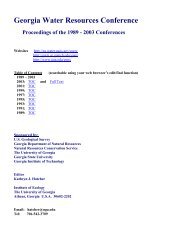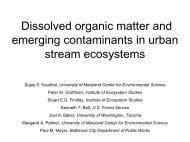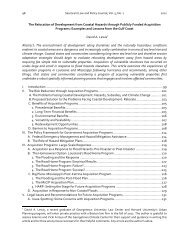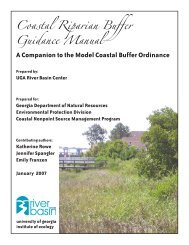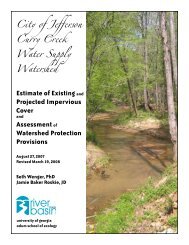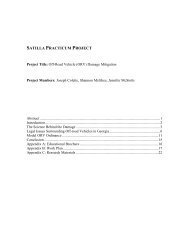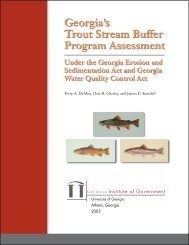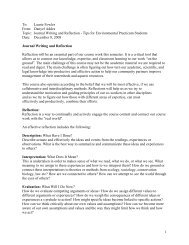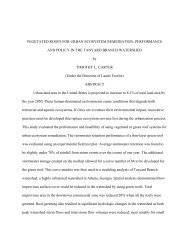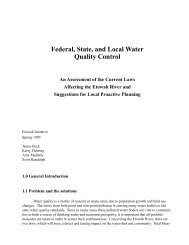The use of constructed wetlands for wastewater treatment
The use of constructed wetlands for wastewater treatment
The use of constructed wetlands for wastewater treatment
Create successful ePaper yourself
Turn your PDF publications into a flip-book with our unique Google optimized e-Paper software.
24 <strong>The</strong> <strong>use</strong> <strong>of</strong> <strong>constructed</strong> <strong>wetlands</strong> <strong>for</strong> <strong>wastewater</strong> <strong>treatment</strong><br />
Glossary<br />
Ammonia volatilisation - It is a process by which Ammonium is converted to Ammonia gas and<br />
followed by volatilisation and occurs only when the pH value in the <strong>wastewater</strong> is higher than the<br />
pK a<br />
value <strong>of</strong> Ammonium.<br />
Ammonification - It is a process whereby Nitrogen-containing organics are mineralized to<br />
Ammoniacal Nitrogen.<br />
Organic Nitrogen ⇔ NH4 +<br />
Biological denitrification - This process involves the removal <strong>of</strong> Nitrate by conversion to<br />
Nitrogen gas under anoxic conditions. Several genera <strong>of</strong> heterotrophic bacteria which are capable<br />
<strong>of</strong> Nitrate reduction include Achromobacter, Aerobacter, Alcaligenes, Bacillus, Brevibacterium,<br />
Flavobactrium, Lactobacillus, Micrococcus, Proteus, Pseudomonas and Spirillum. Two steps are<br />
involved in this process. <strong>The</strong> first step is the conversion <strong>of</strong> Nitrate to Nitrite and will be followed by<br />
the production <strong>of</strong> Nitric Oxide, Nitrous Oxide and Nitrogen gas.<br />
NO 3<br />
- ⇒ NO2<br />
- ⇒ NO ⇒ N2 O ⇒ N 2<br />
Biological nitrification - This is a chemoautotrophic process that involves two microbial genera,<br />
which are Nitrosomonas and Nitrobacter. In the first step, Ammoniacal Nitrogen is converted<br />
to Nitrite and followed by conversion <strong>of</strong> Nitrite to Nitrate in the second step. In the conversion<br />
process, a large amount <strong>of</strong> alkalinity is consumed, resulting in the increase <strong>of</strong> pH values.<br />
NH 4<br />
+ + CO2 + O 2<br />
⇒ Cells + NO 2<br />
-<br />
Nitrosomonas<br />
NO 2<br />
-<br />
+ CO 2<br />
+ O 2<br />
⇒ Cells + NO 3<br />
-<br />
Nitrobacter<br />
Matrix adsorption - Ammoniacal-Nitrogen is adsorbed onto active sites <strong>of</strong> the bed matrix.<br />
However sorption <strong>of</strong> NH 4<br />
-N is reversible as the cation exchange site <strong>of</strong> matrix is saturated and AN<br />
will be released back into the water system.<br />
Reduction - Phosphorus is reduced to gaseous Hydrogen Phosphides (Phosphine and<br />
Diphosphine) under anaerobic conditions by some strains <strong>of</strong> anaerobes and subsequently release<br />
to the atmosphere.<br />
Sorption - Phosphorus sorption is controlled by the interaction <strong>of</strong> redox potential, pH, Fe,<br />
Al and Ca minerals. Inorganic P is retained by Fe and Al oxides and hydroxides, calcite and<br />
organometallic complexes where Phosphate displaces water or hydoxyls from the surface <strong>of</strong> Fe<br />
and Al hydrous oxides to <strong>for</strong>m monodentate and binuclear complexes within the coordination<br />
sphere <strong>of</strong> the hydrous oxide. In acidic conditions, inorganic P is rapidly absorbed on hydrous<br />
oxides <strong>of</strong> Fe and Al and may precipitate as insoluble Fe Phosphates and Al Phosphates.



